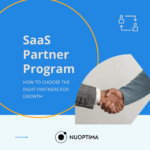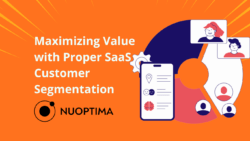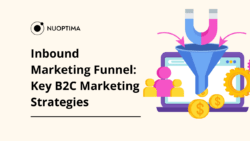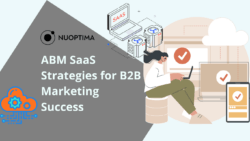In the fast-paced world of B2B SaaS, conversion rates are the heartbeat of success. But what if you could not only understand these rates but master them? What if you could turn mere numbers into a roadmap for growth, innovation, and dominance in your market?
Welcome to the world of B2B SaaS funnel conversion benchmarks—a universe where data meets strategy, where insights become action, and where you can unlock the secrets to skyrocketing your business with the expertise of our SaaS PR agency.
This comprehensive guide is more than just an exploration; it’s a toolkit, a mentor, and a catalyst designed by the experts at our B2B SaaS Agency. From the fundamentals of conversion rates to the cutting-edge trends shaping the future, we’ll journey through real-world examples, actionable strategies, and industry secrets.
Understanding Conversion Rates
1.1 What is a Conversion Rate?
A conversion rate is a metric that measures the percentage of visitors who take a specific action on your website or within your SaaS marketing funnel. This action could be anything from signing up for a newsletter to making a purchase.
For example, if 100 visitors come to your landing page and 5 of them sign up for a free trial, your conversion rate for that action is 5%.
Table 1: Common Conversion Actions in B2B SaaS
| Action | Description |
| Sign Up for Newsletter | Visitor subscribes to receive regular updates and content. |
| Download a Whitepaper | Visitor downloads a free resource, such as a research paper or guide. |
| Register for a Webinar | Visitor registers for an online seminar or workshop. |
| Start a Free Trial | Visitor signs up to try the product or service for free for a limited time. |
| Make a Purchase | Visitor becomes a paying customer. |
1.2 Industry Standards
Conversion rates can vary widely across different industries and even within the same industry. Here’s a look at some median conversion rates for various online actions:
Table 2: Median Conversion Rates by Action
| Action | Median Conversion Rate |
| E-commerce Purchase | 2.0% |
| SaaS Free Trial Sign-up | 7.0% |
| Newsletter Subscription | 5.0% |
| Webinar Registration | 3.0% |
In the context of B2B SaaS, understanding these industry standards is crucial for benchmarking your performance and setting realistic goals.
Example: SaaS Free Trial Sign-up
If the median conversion rate for SaaS free trial sign-ups is 7.0%, and your current rate is 4.0%, this could indicate an area for improvement. By analyzing your sign-up process, optimizing your landing page, and tailoring your offer, you might increase your conversion rate closer to or even beyond the industry standard.
Key Takeaways
- Conversion rates are vital metrics that help you understand how effectively you’re turning visitors into leads or customers.
- Different actions have different conversion rates, and these can vary widely across industries.
- Understanding industry standards can help you benchmark your performance and identify areas for improvement.
- Customization is key: Tailoring your strategies to your specific business context can help you optimize conversion rates and drive growth.
The B2B SaaS Funnel
The B2B SaaS funnel represents the customer’s journey from initial awareness to making a purchase. Understanding this funnel and the conversion rates at each stage is essential for optimizing your marketing and sales strategies.
2.1 Stages of the Funnel
The typical B2B SaaS funnel can be broken down into six main stages:
- Visitor: Anyone who visits your website or landing page.
- Lead: A visitor who shows interest by taking a specific action, such as filling out a contact form.
- Marketing Qualified Lead (MQL): A lead that meets certain criteria, such as engaging with specific content or fitting a target demographic.
- Sales Qualified Lead (SQL): An MQL that demonstrates a clear intent to purchase and meets additional qualification criteria.
- Opportunity: An SQL that is actively engaged in the buying process.
- Close: A successful sale or conversion to a paying customer.
Table 3: Stages of the B2B SaaS Funnel
| Stage | Description |
| Visitor | Anyone who visits your site. |
| Lead | A visitor who shows interest. |
| Marketing Qualified Lead | A lead that fits marketing criteria. |
| Sales Qualified Lead | An MQL with clear purchase intent. |
| Opportunity | An SQL engaged in buying. |
| Close | A successful sale. |
2.2 Inbound vs. Outbound Marketing
Inbound and outbound marketing represent two different approaches to attracting and converting customers. Here’s how they compare in the context of the B2B SaaS funnel:
Table 4: Inbound vs. Outbound Conversion Rates
| Stage | Inbound Conversion Rate | Outbound Conversion Rate |
| Contacts to MQL | 5.00% | 15.00% |
| MQL to SAL | 20.00% | 42.50% |
| SAL to SQL | 43.75% | 55.00% |
| SQL to Opportunities | 63.33% | 50.00% |
| Opportunities to Wins | 43.33% | 37.50% |
| All-up (Visitor to Win) | 0.05% | 0.03% |
Key Takeaways
- Understanding the Funnel: Knowing the stages of the funnel and the typical conversion rates at each stage helps you identify bottlenecks and opportunities for improvement.
- Inbound vs. Outbound: Different marketing approaches have different conversion rates, and understanding these differences can help you tailor your strategies.
- Continuous Optimization: Regularly analyzing and optimizing your funnel can lead to increased conversion rates and revenue growth.
Conversion Benchmarks by Business Model
B2B SaaS companies often operate under different business models, each with its unique conversion benchmarks. Understanding these models and their respective benchmarks can help you tailor your strategies and optimize your conversion rates.
3.1 Low-Touch Business Models
Low-touch business models typically involve minimal human interaction, relying on automated processes and self-service options.
Table 5: Low-Touch Conversion Benchmarks
| Model | Satisfactory Rate | Good Rate | Excellent Rate |
| Freemium | 1% | 3% | 10% |
| Free Trials without Credit Card | 1% | 2% | 5% |
| Free Trials with Credit Card | 25% | 40% | 60% |
Example: Freemium Model
In a freemium model, where users can access basic features for free and pay for premium features, a satisfactory conversion rate might be around 1%. However, companies like Slack have achieved conversion rates as high as 30% by offering exceptional value and a seamless transition to paid plans.
3.2 High-Touch Business Models
High-touch business models involve more personalized interactions, often requiring sales teams to engage with potential customers.
Table 6: High-Touch Conversion Benchmarks (Inbound)
| Stage | Average Conversion Rate |
| Lead to Closing | 0.05% |
Table 7: High-Touch Conversion Benchmarks (Outbound)
| Stage | Average Conversion Rate |
| Lead to Closing | 0.03% |
Key Takeaways
- Different Models, Different Benchmarks: Low-touch and high-touch business models have distinct conversion benchmarks, reflecting their unique approaches to customer engagement.
- Understanding Your Model: Knowing which business model you operate under and the corresponding benchmarks can help you set realistic goals and tailor your strategies.
- Continuous Improvement: Regularly analyzing your conversion rates against industry benchmarks and adapting your strategies can lead to ongoing growth and success.
Conversion Benchmarks by Channel
Different marketing channels have varying conversion rates, and understanding these differences can help you allocate resources effectively and tailor your strategies to each channel.
4.1 Social Media
Social media platforms like Facebook, LinkedIn, and Twitter can be powerful tools for reaching and engaging your target audience.
Table 8: Social Media Conversion Benchmarks
| Platform | Average Conversion Rate |
| 0.77% | |
| 2.74% | |
| 0.69% |
4.2 Email Marketing
Email marketing remains one of the most effective channels for nurturing leads and driving conversions.
Table 9: Email Marketing Conversion Benchmarks
| Action | Average Conversion Rate |
| Open Rate | 20.81% |
| Click-Through Rate | 2.43% |
| Conversion Rate | 4.29% |
4.3 Paid Search and Advertising
Paid search and advertising channels like Google Ads can help you reach potential customers actively searching for your products or services.
Table 10: Paid Search Conversion Benchmarks
| Platform | Average Conversion Rate |
| Google Ads | 3.75% |
| Bing Ads | 2.94% |
4.4 SaaS Form Pages
Conversion rates for SaaS form pages can vary widely depending on the design, offer, and target audience.
Table 11: SaaS Form Page Conversion Benchmarks
| Action | Average Conversion Rate |
| Sign-up Form | 5.0% |
| Contact Form | 3.0% |
| Download Form | 7.0% |
Key Takeaways
- Channel-Specific Strategies: Different channels have unique conversion benchmarks, and understanding these can help you create tailored strategies for each.
- Resource Allocation: Knowing the conversion rates of various channels can guide your budgeting and resource allocation decisions.
- Continuous Monitoring and Optimization: Regularly tracking and analyzing conversion rates across channels can help you identify opportunities for improvement and adapt your strategies for better results.
Case Studies and Real-World Examples
Learning from real-world examples and case studies can provide valuable insights into how different companies have successfully navigated the complexities of B2B SaaS funnel conversion benchmarks. Here are some illustrative examples:
5.1 Slack: Mastering the Freemium Model
Challenge: Converting free users to paid subscribers in a highly competitive market.
Strategy: Slack offered a seamless user experience with clear value propositions, encouraging free users to explore premium features.
Result: An impressive 30% conversion rate from freemium to paid subscriptions, well above industry standards.
5.2 HubSpot: Optimizing Email Marketing
Challenge: Increasing click-through and conversion rates for email campaigns.
Strategy: HubSpot implemented personalized content, A/B testing, and segmented targeting to engage different customer segments.
Result: A 25% increase in click-through rates and a 20% increase in conversion rates.
5.3 Dropbox: Leveraging Referral Marketing
Challenge: Expanding user base without a massive advertising budget.
Strategy: Dropbox implemented a referral program, offering extra storage space for both referrer and referee.
Result: A 60% increase in sign-ups, contributing significantly to Dropbox’s rapid growth.
5.4 Adobe: Enhancing Paid Search Performance
Challenge: Maximizing ROI on paid search campaigns.
Strategy: Adobe used advanced targeting, keyword optimization, and continuous monitoring to refine its Google Ads campaigns.
Result: A 25% increase in conversion rates and a 15% reduction in cost per conversion.
Key Takeaways
- Learning from Success: Analyzing successful case studies can provide actionable insights and inspiration for your own strategies.
- Adaptation and Innovation: Each company faced unique challenges and found innovative ways to adapt industry benchmarks to their specific context.
- Continuous Improvement: Regular analysis, testing, and optimization were common themes across these examples, leading to significant improvements in conversion rates.
How to Optimize Conversion Rates
Optimizing conversion rates is an ongoing process that requires a combination of best practices, tools, technologies, and a willingness to test and learn. Here’s a comprehensive guide to help you enhance your conversion rates:
6.1 Best Practices
A. Landing Page Optimization
- Clear Value Proposition: Clearly articulate what you offer and why it’s valuable.
- Compelling Call-to-Action (CTA): Use persuasive language that encourages visitors to take action.
- Visual Appeal: Include high-quality images and design that align with your brand.
B. Emotional Triggers
- Build Trust: Use testimonials, reviews, and trust badges.
- Create Urgency: Limited-time offers or countdown timers can prompt action.
- Address Objections: Provide answers to common questions or concerns.
C. Short Sign-Up Forms
- Ask Only What’s Necessary: Reduce friction by requesting only essential information.
- Provide Guidance: Use tooltips or examples to guide users through the process.
6.2 Tools and Technologies
A. A/B Testing
- Test Different Versions: Compare different versions of a page or element to see what performs best.
- Use Tools Like: Optimizely, Unbounce, or Google Optimize.
B. Tracking and Analytics
- Monitor Performance: Use tools like Google Analytics to track conversion rates and user behavior.
- Set Up Goals: Define and measure specific conversion goals.
C. Personalization and Automation
- Tailor Content: Use tools like HubSpot or Marketo to personalize content based on user behavior or segments.
- Automate Processes: Implement automated email campaigns or lead nurturing sequences.
6.3 Customizing Benchmarks
- Understand Your Audience: Tailor benchmarks to your specific target audience and business model.
- Set Realistic Goals: Use industry benchmarks as a starting point, but adapt them to your unique context.
- Iterate and Improve: Continuously monitor, analyze, and refine your strategies.
Key Takeaways
- Holistic Approach: Optimizing conversion rates requires a combination of best practices, tools, technologies, and continuous learning.
- Customization is Key: Tailor your strategies to your specific business context, audience, and goals.
- Embrace Testing and Learning: Regular testing, analysis, and refinement can lead to ongoing improvements and success.
Future Trends and Challenges
The landscape of B2B SaaS funnel conversion benchmarks is ever-evolving, shaped by technological advancements, changing customer behaviors, and market dynamics. Here’s a look at some future trends and challenges that may impact conversion rates:
7.1 Increasing Role of Artificial Intelligence (AI) and Machine Learning (ML)
- Predictive Analytics: Using AI to predict customer behavior and personalize offers.
- Automated Optimization: ML algorithms that continuously optimize conversion funnels.
7.2 Shift Towards Customer-Centric Approaches
- Customer Journey Mapping: Understanding and optimizing the entire SaaS customer journey, not just individual touchpoints.
- Value-Based Marketing: Focusing on delivering genuine value rather than pushing sales.
7.3 Growing Importance of Privacy and Security
- Data Privacy Regulations: Compliance with laws like GDPR and CCPA.
- Building Trust: Transparent handling of customer data and robust security measures.
7.4 Changes in Win Rates and Stakeholder Involvement
- Longer Sales Cycles: Increasing complexity of B2B sales may lead to longer cycles.
- More Decision-Makers: More stakeholders involved in the buying process, requiring tailored communication.
7.5 Adapting to Market Changes and Uncertainties
- Economic Fluctuations: Economic conditions can impact budgets and buying decisions.
- Pandemic-Related Shifts: Changes in remote work, digital adoption, and customer needs.
Key Takeaways
- Stay Ahead of Trends: Regularly monitor and adapt to emerging trends and technologies.
- Embrace Customer-Centricity: Focus on delivering value and understanding the entire customer journey.
- Navigate Challenges with Agility: Be prepared to adapt to legal, economic, and market challenges.
- Continuous Learning and Adaptation: The future of conversion optimization requires ongoing learning, testing, and adaptation to stay competitive.
Discover how to leverage customer testimonials for your marketing strategy by tuning into the Nuoptima SaaS Podcast featuring Sam Shepler from TestimonialHero.
Conclusion
The world of B2B SaaS funnel conversion benchmarks is both complex and fascinating. As we’ve explored throughout this comprehensive guide, understanding and optimizing conversion rates is not a one-size-fits-all endeavor. It requires a deep understanding of various factors, including industry standards, business models, marketing channels, customer behaviors, and emerging trends.
From the foundational understanding of what conversion rates are to the intricacies of different business models and marketing channels, we’ve provided real-world examples, insights from industry experts, and actionable strategies. Whether you’re new to the concept or looking to deepen your understanding, we hope this guide has served as a valuable resource.
Here’s a recap of the key takeaways:
- Understanding Conversion Rates: Knowing what conversion rates are, why they matter, and how they vary across industries and actions.
- Navigating the B2B SaaS Funnel: Understanding the stages of the funnel and the conversion rates at each stage.
- Tailoring Strategies to Business Models: Recognizing the differences between low-touch and high-touch business models and their respective benchmarks.
- Optimizing Across Channels: Understanding how different marketing channels perform and how to tailor strategies to each.
- Learning from Real-World Examples: Gaining insights from successful case studies and real-world examples.
- Embracing Best Practices and Tools: Utilizing best practices, tools, and technologies to optimize conversion rates.
- Preparing for the Future: Staying ahead of emerging trends and challenges to remain competitive and agile.
In the ever-changing landscape of B2B SaaS, continuous learning, testing, and adaptation are vital. By leveraging the insights and strategies outlined in this guide, you can set your business on a path to better performance, increased revenue, and sustainable growth. Engaging with a SaaS lead generation agency can further enhance these efforts, providing specialized expertise and innovative approaches tailored to the unique challenges of B2B SaaS marketing.
Thank you for joining us on this insightful journey through the multifaceted landscape of B2B SaaS conversion rates. May your efforts to understand, measure, analyze, and optimize your conversion rates lead to success and fulfillment in your endeavors.



